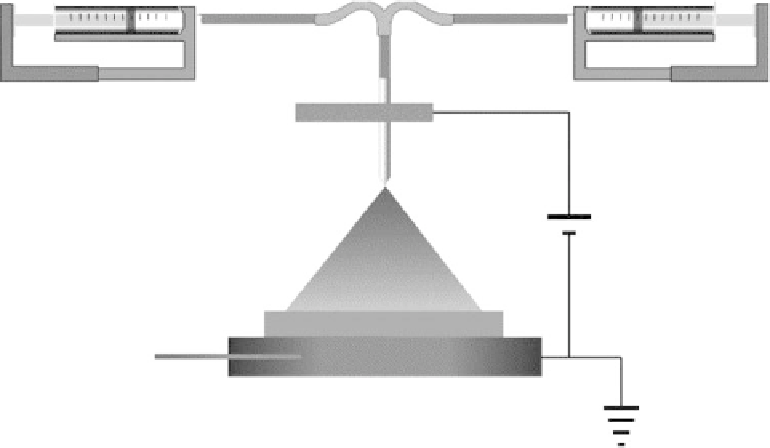Biomedical Engineering Reference
In-Depth Information
the implant materials and surrounding osseous tissue, resulting in a strong interface between the
implant surface and bone [69]. Currently, plasma spraying is often used to coat titanium implants
with synthetic CaP fi lms and coatings. However, the CaP phases like carbonate apatite, which
resembles the composition and crystallinity of bone minerals, is diffi cult to be deposited because
of the extremely high processing temperatures [9,70]. Electrospraying has already been developed
as a novel coating technique to overcome the above-mentioned drawback. The experimental results
showed that the chemical properties of CaP coatings prepared using electrospraying technique
were strongly dependent on the chemical and physical properties of the precursor solution. Various
crystal phases and phase mixtures were formed, such as carbonate apatite, β-TCP, Mg-substituted
whitlockite, monetite, β/γ-pyrophosphate, and calcite, by varying the relative Ca/P solution ratio,
absolute precursor concentration, acidity of the precursor solution, and the type of Ca precursor
salt. The results showed that carbonate played an essential role in the chemical mechanism for the
formation of CaP coatings. Depending on the processing parameters of electrospraying, there were
three reactions for carbonate anions: (1) reaction with acidic phosphate groups, (2) incorporation
into apatitic CaP phases, and (3) reaction with excessive Ca
2
+
cations in case of phosphate-defi cient
precursor solutions.
Leeuwenburgh et al. also investigated the fabrication of CaP coatings with defi ned chemical
properties through electrospraying [71]. The relationships between various processing parameters
and the chemical properties of CaP coatings were studied to prepare the CaP coatings with tailored
chemical characteristics. The experimental results showed that the chemical properties of the CaP
coatings could be determined by the physical and chemical properties of solutions, as well as the
apparatus-related factors. Figure 11.20 shows a schematic diagram of the setup. Ca and P precursors
were prepared by dissolving Ca(NO
3
)
2
·4H
2
O or CaCl
2
·2H
2
O and H
3
PO
4
in butyl carbitol (C
8
H
18
O
3
)
or ethanol. A two-component nozzle with separate inlets for Ca and P precursor solutions was used
as a standard nozzle to avoid premature precipitation of precursors prior to the spraying generation.
By varying the processing parameters, the chemical properties of CaP coatings can be tailored to
have defi ned crystal phases ranging from the carbonate-free phases to carbonate-containing phases.
The experiment demonstrated that electrospraying was an appropriate technique to prepare coat-
ings with a large variety of chemical properties, which is especially suitable to the research focused
Liquid in
Nozzle
High-voltage supply
Aerosol spray
Substrate
Thermo
couple
Heating element
FIGURE 11.20
A diagram of the setup of the electrospraying for two solutions. (Reprinted from
Leeuwenburgh, S.C.G. et al.,
J. Eur. Ceram. Soc.
, 26, 487, 2006. © Elsevier Science. With permission.)


